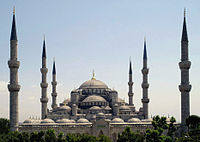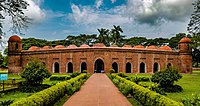Islamic culture

| Part of a series on |
| Islamic culture |
|---|
| Architecture |
| Art |
| Clothing |
| Holidays |
|
| Literature |
| Music |
|
Theatre |
| Part of a series on |
| Islam |
|---|
 |
Islamic culture or Muslim culture refers to the historic cultural practices that developed among the various peoples living in the Muslim world. These practices, while not always religious in nature, are generally influenced by aspects of Islam, particularly due to the religion serving as an effective conduit for the inter-mingling of people from different ethnic/national backgrounds in a way that enabled their cultures to come together on the basis of a common Muslim identity. The earliest forms of Muslim culture, from the Rashidun Caliphate to the Umayyad Caliphate and the early Abbasid Caliphate, was predominantly based on the existing cultural practices of the Arabs, the Byzantines, and the Persians. However, as the Islamic empires expanded rapidly, Muslim culture was further influenced and assimilated much from the Iranic, Caucasian, Turkic, Indian, Malay, Somali, Berber, and Indonesian cultures.
Owing to a variety of factors, there are variations in the application of Islamic beliefs in different cultures and traditions.[1]
Language and literature
Arabic
Arabic literature emerged in the 5th century with only fragments of the written language appearing before then. The
Persian/Iranic
Not all Persian literature is written in Persian; works written by ethnic Persians in other languages, such as Greek and Arabic, are sometimes included. At the same time, not all literature written in Persian is written by ethnic Persians or Iranians; Turkic, Caucasian, and Indian poets and writers have also used the Persian language in the environment of Persianate societies.
Described as one of the great literatures of humanity,
Persian poets such as
Indic
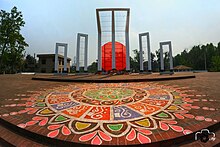
For a thousand years, since the invasion of India by the
In
Turkic
From the 11th century, there was a growing body of Islamic literature in the
Art

Public
Depiction of animate beings

Some interpretations of Islam include a ban of depiction of animate beings, also known as aniconism. Islamic aniconism stems in part from the prohibition of idolatry and in part from the belief that creation of living forms is God's prerogative. Although the
Calligraphy
Islamic calligraphy is the artistic practice of
The development of Islamic calligraphy is strongly tied to the
Islamic calligraphy developed from two major styles: Kufic and Naskh. There are several variations of each, as well as regionally specific styles. Islamic calligraphy has also been incorporated into modern art beginning with the post-colonial period in the Middle East, as well as the more recent style of calligraffiti.
Architecture
-
Northeast entrance toDelhi, India's Jama Masjid.
-
The fortress-palace of Alhambra, built in the 11th century, is a large monument and a popular tourist attraction.
-
Sultan Ahmed Mosquewas completed in 1616.
-
The 15th-centuryKhalifatabad in Bangladesh is an example of the Bengal Sultanatearchitecture.
Elements of Islamic style
Islamic architecture may be identified with the following design elements, which were inherited from the first mosque built by Muhammad in Medina, as well as from other pre-Islamic features adapted from churches and synagogues.
- Large courtyards often merged with a central prayer hall (originally a feature of the Masjid al-Nabawi).
- erected between the 2nd and the 3rd century, it is a majestic square tower consisting of three superimposed tiers of gradual size and decor.
- A Copticchurches.
- Domes (the earliest Islamic use of which was in the 8th-century mosque of Medina).
- Use of iwans to intermediate between different sections.
- Use of geometric shapes and repetitive art (arabesque).
- Use of decorative Arabic calligraphy.
- Use of symmetry.
- Ablution fountains.
- Use of bright colour.
- Focus on the interior space of a building rather than the exterior.
Theatre
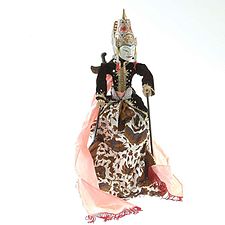
Whilst theatre is permitted by Islam,
The most popular forms of theatre in the
One of the oldest, and most enduring, forms of puppet theatre is the Wayang of Indonesia. Although it narrates primarily pre-Islamic legends, it is also an important stage for Islamic epics such as the adventures of Amir Hamzah (pictured). Islamic Wayang is known as Wayang Sadat or Wayang Menak.
In other areas the style of shadow puppetry known as khayal al-zill – an intentionally metaphorical term whose meaning is best translated as 'shadows of the imagination' or 'shadow of fancy' survives. This is a shadow play with live music .."the accompaniment of drums, tambourines and flutes...also..."special effects" – smoke, fire, thunder, rattles, squeaks, thumps, and whatever else might elicit a laugh or a shudder from his audience"[38]
In Iran puppets are known to have existed much earlier than 1000, but initially only glove and string puppets were popular in Iran.[39] Other genres of puppetry emerged during the Qajar era (18th–19th century) as influences from Turkey spread to the region. Kheimeh Shab-Bazi is a Persian traditional puppet show which is performed in a small chamber by a musical performer and a storyteller called a morshed or naghal. These shows often take place alongside storytelling in traditional tea and coffee-houses (Ghahve-Khave). The dialogue takes place between the morshed and the puppets. Puppetry remains very popular in Iran, the touring opera Rostam and Sohrab puppet opera being a recent example.
The
Following the
Dance
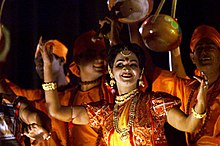
Many forms of dancing arts are practised in Muslim cultures, both in religious
Some scholars of Islamic
Most of the religious orders (
Notable examples include the
In
The
Other examples of devotional dance are found in the Maghreb where it is associated with gnawa music, as well as Sub-Saharan Africa and South-East Asia. The Naqshbandi order, predominant among Iran's Sunni minority, is a notable exception in that they do not use music and dancing in the context of dhikr.
In addition to these strictly religious forms of dance, colourful dancing processions traditionally take place in Muslim communities during weddings and public celebrations such as
Although tariqas and their rituals have been an omnipresent part of Muslim life for most of Islam's history and were largely responsible for the spread of Islam throughout the world, their following and influence has sharply declined since the late 19th century, having been vigorously opposed and combated in turns by the
Music
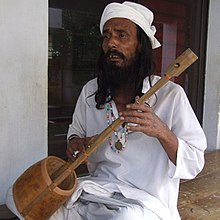
Many Muslims are very familiar to listening to music. The classic heartland of
is a multicultural religion, the musical expression of its adherents is diverse.- Arab classical music
- Religious music in Iran
- Hindustani classical music
- Qawwali music
The
Sub-Saharan
All these regions were connected by trade long before the Islamic conquests of the 7th century and later, and it is likely that musical styles travelled the same routes as trade goods. However, lacking recordings, we can only speculate as to the pre-Islamic music of these areas. Islam must have had a great influence on music, as it united vast areas under the first caliphs, and facilitated trade between distant lands. Certainly the
See articles on
Family life
In a Muslim family, the birth of a child is attended with some religious ceremonies. Immediately after the birth, the words of Adhan is pronounced in the right ear of the child.[52] In the seventh day, the aquiqa ceremony is performed, in which an animal is slaughtered and its meat is distributed among the poor.[53] The head of the child is also shaved, and an amount of money equaling the weight of the child's hair is donated to the poor.[53] Apart from fulfilling the basic needs of food, shelter, and education, the parents or the elderly members of family also undertake the task of teaching moral qualities, religious knowledge, and religious practices to the children.[54] Marriage, which serves as the foundation of a Muslim family, is a civil contract which consists of an offer and acceptance between two qualified parties in the presence of two witnesses. The groom is required to pay a bridal gift (mahr) to the bride, as stipulated in the contract.[55] With Muslims coming from diverse backgrounds including 49 Muslim-majority countries, plus a strong presence as large minorities throughout the world there are many variations on Muslim weddings. Generally in a Muslim family, a woman's sphere of operation is the home and a man's corresponding sphere is the outside world. However, in practice, this separation is not as rigid as it appears.[56]
Certain religious rites are performed during and after the death of a Muslim. Those near a dying man encourage him to pronounce the Shahada as Muslims want their last word to be their profession of faith. After the death, the body is appropriately bathed by the members of the same gender and then enshrouded in a threefold white garment called kafan.[57] Placing the body on a bier, it is first taken to a mosque where funeral prayer is offered for the dead person, and then to the graveyard for burial.
Etiquette and diet
Many practices fall in the category of adab, or Islamic etiquette. This includes greeting others with "
Martial arts

- Pahlavani – Iran
- Yağlı güreş – Turkey
- Gatka – Pakistan
- Kurash – Central Asia
- Istunka – Somalia
- Nuba fighting – Sudan
- Tahtib – Egypt
- Laamb Wrestling – Senegal
- Dambe – Nigeria
- Jobbarer Boli Khela – Bangladesh
- Mokkar Boli Khela – Bangladesh
- Lathi Khela – Bangladesh
- Sqay – India
- Pencak silat – Indonesia
- Bakti Negara – Indonesia
- Perisai Diri – Indonesia
- Kuntao – Indonesia
- Tarung Derajat – Indonesia
- Silat – Indonesia
- Silat Melayu – Malaysia
- Seni Gayung Fatani – Malaysia
- Seni Gayong – Malaysia
- Tomoi – Malaysia
- Lian padukan – Malaysia
- West Asian
See also
- Cultural Muslim
- Islamicate
- Islam in South Asia
- Islamic advice literature
- Islamic literature
- Muslim meme
References
- ^ "Minds unmade". The Economist. 4 May 2013.
- ^ Jones, p. ix.
- ISBN 9780936347356.
- ISBN 978-9004201453.
- ISBN 9781136258466.
- ISBN 0-19-821905-9, p. 200.
- ^ Von David Levinson; Karen Christensen, Encyclopedia of Modern Asia, Charles Scribner's Sons. 2002, vol. 4, p. 480
- ^ Frye, R. N., "Darī", The Encyclopaedia of Islam, Brill Publications, CD version.
- ^ C. A. (Charles Ambrose) Storey and Franço de Blois (2004), "Persian Literature - A Biobibliographical Survey: Volume V Poetry of the Pre-Mongol Period", RoutledgeCurzon; 2nd revised edition (June 21, 2004). p. 363: "Nizami Ganja'i, whose personal name was Ilyas, is the most celebrated native poet of the Persians after Firdausi. His nisbah designates him as a native of Ganja (Elizavetpol, Kirovabad) in Azerbaijan, then still a country with an Iranian population, and he spent the whole of his life in Transcaucasia; the verse in some of his poetic works which makes him a native of the hinterland of Qom is a spurious interpolation."
- ^ Franklin Lewis, Rumi Past and Present, East and West, Oneworld Publications, 2000. How is it that a Persian boy born almost eight hundred years ago in Khorasan, the northeastern province of Greater Iran, in a region that we identify today as Central Asia, but was considered in those days as part of the Greater Persian cultural sphere, wound up in Central Anatolia on the receding edge of the Byzantine cultural sphere, in which is now Turkey, some 1500 miles to the west? (p. 9)
- ^ Rabbani, AKM Golam (7 November 2017). "Politics and Literary Activities in the Bengali Language during the Independent Sultanate of Bengal". Dhaka University Journal of Linguistics. 1 (1): 151–166. Archived from the original on 11 October 2017. Retrieved 7 November 2017 – via www.banglajol.info.
- ^ "Commemorating the International Mother Language Day- February 21". NewsGram. 21 February 2016. Archived from the original on 8 May 2016. Retrieved 6 May 2016.
- ^ "Language Movement". Banglapedia. Archived from the original on 7 March 2016. Retrieved 6 May 2016.
- ISBN 9231028138p 734
- ISBN 1438110251p 322
- ISBN 0754674061p 409
- ^ ISBN 9971774887p 69
- ISBN 978-0-674-02390-1.
- ^ a b Esposito, John L. (2011). What Everyone Needs to Know about Islam (2nd ed.). Oxford University Press. pp. 14–15.
- ^ a b "Figural Representation in Islamic Art". The Metropolitan Museum of Art.
- ISBN 0-300-06465-9.
- ISBN 978-979-099-631-1
- ^ Julia Kaestle (10 July 2010). "Arabic calligraphy as a typographic exercise".
- ^ Blair, Sheila S. (Spring 2003). "The Mirage of Islamic Art: Reflections on the Study of an Unwieldy Field". The Art Bulletin. 85: 152–184 – via JSTOR.
- ISBN 0944940005.
- ^ Roxburgh, David J. (2008). ""The Eye is Favored for Seeing the Writing's Form": On the Sensual and the Sensuous in Islamic Calligraphy". Muqarnas. 25: 275–298 – via JSTOR.
- ^ Krautheimer, Richard. Early Christian and Byzantine Architecture Yale University Press Pelican History of Art, Penguin Books Ltd., 1965, p. 285.
- ^ Fletcher, Banister A History of Architecture on the Comparative Method 4th Edition, London, p. 476.
- ^ Copplestone, p.149
- ^ "A Tour of Architecture in Islamic Cities". Archived from the original on 2007-03-17. Retrieved 2018-12-10.
- ISBN 978-0-8264-9423-8.
- ^ "Kairouan Capital of Political Power and Learning in the Ifriqiya". Muslim Heritage. Retrieved 2014-03-16.
- ISBN 9781933316659. Retrieved 2014-03-16.
- ISBN 9781576070048. Retrieved 2014-03-16.
- ISBN 0-415-96691-4.
- ISBN 965-264-014-X
- ^ Tradition Folk The Site by Hayali Mustafa Mutlu
- ^ Article Saudi Aramco World 1999/John Feeney
- ISBN 0-934211-29-9: Mage 2005
- OL 30677644M. Retrieved 23 April 2024.
- ISBN 0-7591-0190-6.
- ISBN 0-253-21729-6.
- ISBN 0-7923-3342-X.
- ^ Al-Ghazzali. The Alchemy of Happiness (Chapter 5: Concerning Music and Dancing as Aids to the Religious Life).
- ^ "Reliance of the Traveller (Umdat ul-Salik); Section r40.4 on "Dancing", p. 794" (PDF). Archived from the original (PDF) on 2018-05-20. Retrieved 2018-05-19.
- ^ Ghazzālī, and Claud Field. The Alchemy of Happiness. Armonk, N.Y.: M.E. Sharpe, 1991.
- ISBN 0-7914-1155-9.
- ^ The Mevlevi Sama Ceremony UNESCO.
- ^ "Steeped in ancient mysticism, passion of Pakistani Sufis infuriates Taliban". DAWN.COM. September 27, 2013.
- ^ Akhtar, Suleman (February 20, 2017). "Damadam mast Qalandar is a cry of rebellion against established orders". DAWN.COM.
- ^ Sharma, Devesh. "Beyond borders Runa Laila". Filmfare.com. Times Internet Limited. Archived from the original on 6 March 2016. Retrieved 21 May 2019.
- ISBN 978-0-8160-5454-1.
- ^ ISBN 978-0-253-21627-4.
- ISBN 978-0-8160-5454-1.
- ^
- Waines (2003, pp. 93–96)
- The Oxford Dictionary of Islam (2003), p. 339
- Esposito (1998, p. 79)
- ISBN 978-0946621842.
- ISBN 978-1-61530-060-0.
- ^
- Quran 5:5
- Curtis (2005, p. 164)
- Esposito (2002b, p. 111)
- Ghamidi (2001): Customs and Behavioral Laws Archived 2013-09-23 at the Wayback Machine
- Ghamidi (2001): The Dietary Laws Archived 2007-05-02 at the Wayback Machine
- Ghamidi (2001): Various types of the prayer Archived 2013-09-23 at the Wayback Machine
- Ersilia Francesca. "Slaughter". Encyclopaedia of the Qur'an Online.
- https://quran.com/16/115
- https://quran.com/49
- https://www.islamicstudies.info/tafheem.php?sura=6&verse=145&to=150
- http://islamicstudies.info/reference.php?sura=5&verse=3
Works cited
- Curtis, Patricia A. (2005). A Guide to Food Laws and Regulations. Blackwell Publishing Professional. ISBN 978-0-8138-1946-4.
- ISBN 978-0-19-511234-4.
- Esposito, John (2002b). What Everyone Needs to Know about Islam. Oxford University Press. ISBN 978-0-19-515713-0.
- Waines, David (2003). An Introduction to Islam. Cambridge University Press. ISBN 978-0-521-53906-7.
Further reading
- Rosenthal, Franz (1977). The Classical Heritage in Islam, in series, Arabic Thought and Culture. transl. from the German by Emilie and Jenny Marmorstein. [Pbk. ed.]. London: Routledge, 1992. xx, 298 p., sparsely ill. N.B.: "First published in English in 1975 by Routledge & Kegan, Paul" in the hardcover ed. ISBN 0-415-07693-5.
External links
 Media related to Muslim culture at Wikimedia Commons
Media related to Muslim culture at Wikimedia Commons


![The Great Mosque of Kairouan also called the Mosque of Uqba is at the same time the oldest mosque in North Africa (founded in 670 and still used as a place of worship) and one of the most important monuments of Islamic civilisation,[31][32] situated in Kairouan, Tunisia.](http://upload.wikimedia.org/wikipedia/commons/thumb/f/fe/Kairouan_Mosque_Courtyard.jpg/200px-Kairouan_Mosque_Courtyard.jpg)

